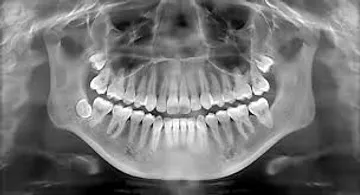There have been some recent articles and controversy in the news in regards to x-rays (medical & dental). We have decided to devote this issue of our Newsletter to answer our patient’s questions and explain our office protocol in regards to x-rays. Benefits of Dental X-rays Dental X-rays help us detect cavities, infections, gum disease, cysts, tumors and developmental abnormalities much sooner than waiting for these problems to get large enough to become evident to the naked eye; or painful enough to become uncomfortable and noticeable to the patient. Dentistry has led the healing professions in preventive care since the 1940’s and x-rays help us each and every day in finding and treating dental disease in its earliest and easiest to treat stages. Patients who receive regular exams and x-rays tend to retain their teeth for life, while patients who go without exams and x-rays tend to have more root canals and extractions. By the time the problem has become uncomfortable or noticeable to the patient, the decay or problem has already progressed too far. Risks of Dental X-rays We gathered the following information from the American Nuclear Society website to put the amount of radiation from Dental X-rays in perspective.
| SOURCE OF RADIATION | Estimated Exposure (mrem) Air Travel 0.5 per HOUR |
| Dental Bitewings (4) | 2 |
| Dental Complete Series of X-rays | 10 |
| Medical Chest X-ray (1 film) | 10 |
| Natural Radiation from the Ground | 30 per year |
| Natural Cosmic Radiation in Central Oregon | 41 per year |
| Medical X-ray (Mammography) | 42 |
| Medical CT Scan – Head | 200 |
| Internal Radiation from Food & Air | 286 per year |
| Medical Upper GI X-rays | 600 |
| Medical CT Scan of Abdomen/Pelvis | 1000 |
As you can see from the table above, radiation exposure from dental x-rays is extremely low, in comparison to other forms of radiation that we are routinely exposed to. We also take the added precaution of routinely covering our patients with a lead apron and Thyroid collar to further minimize the already low exposure levels. International standards have recommended a maximum amount of radiation for humans working with or around radioactive materials at 5,000 mrem per year. The average accumulated amount of radiation per person is approximated at 620 per year. You can calculate your own annual radiation dose by visiting the American Nuclear Society website (www.ans.org), and clicking ‘Resources’ and then ‘Dose Chart’.
SKYLINE DENTAL X-ray General Recommendations & Protocol Our goal is to take the very best care of your teeth and mouth as possible. In order to do that, we need periodic x-rays to properly diagnose and treat conditions that might exist or arise in your mouth. We realize that different patients and different dental conditions require different protocols. We have always strived to minimize our patient’s x-ray exposure and at the same time reduce the costs associated with necessary x-rays.
We do not have a one-size fits all x-ray routine in our office, but have tailored our X-ray Protocol to benefit each specific patient’s dental and medical conditions. Patients who have a higher risk of decay, multiple existing restorations or more complex treatment plans require more frequent and regular dental x-rays. Patients who have experienced fewer cavities and restorations in their past, and have exhibited a smaller risk of dental disease, will continue to have less frequent dental x-rays recommended to them. Our X-ray Protocol also takes into account numerous other important factors; such as pregnancy, patient’s age, medical history & list of medications (dry mouth, acid reflux, concurrent radiation therapy, etc…)
We will continue to honor the trust that our patients have placed in us, by taking the necessary steps to properly diagnose and treat their dental problems, while remaining respectful of our patient’s wishes for a protocol that caters to each patient as an individual. With our X-ray Recommendations and Protocols, we hope to provide the right balance between our patient’s wishes for reduced exposure to radiation and the Oregon Board of Dentistry’s Standard of Care for dental practices. Please let us know if you have any questions or concerns.
Excerpts from the American Dental Association (www.ada.org)
and the American Nuclear Society (www.ans.org)


